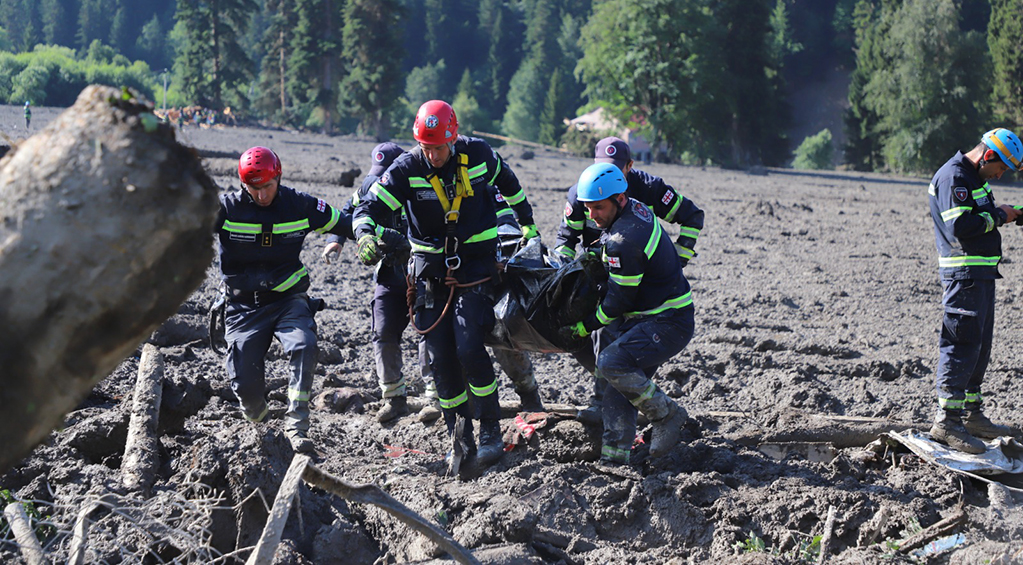The Georgian government is trying to dodge responsibility for the Shovi tragedy with exactly the same reasoning as the Russian government justified itself with before the Strasbourg Court in 2008. The European Court of Human Rights in the case ‘’Budayeva and others v. Russia’’ did not share the position of the defendant, who was arguing that the force of the landslide was insurmountable and impossible to predict or stop. The court found that the disaster, which killed 8 people, was foreseeable, and by not having an appropriate early warning system and inadequate management, the government did not fulfill its obligation and failed to ensure the effective protection of the right to life.
News
In the summer of 2000, a landslide occurred in the Russian city of Tyrnyauz. Six Russian citizens appealed to the Strasbourg Court. Some of the petitioners lost family members in the disaster, while others had their houses destroyed. The Russian prosecutor's office refused to investigate the causes of the landslide and ruled the deaths accidental.
The victims disputed the violation of Articles 2 (right to life), 8 (Right to respect for private and family life), and 13 (Right to an effective remedy) of the European Convention on Human Rights. They claimed that the Russian authorities put their right to life at risk during the natural disaster and did not take preventive measures to avoid casualties. The plaintiffs accused the Russian authorities of failing to repair the malfunctioning earth containment equipment, of failing to issue an advance warning of the threat of the oncoming disaster, and of failing to investigate the incident.
According to the Russian government, the authorities have taken all reasonable measures to reduce the risks, but due to the overwhelming force of the landslide, it was impossible to predict or stop.
According to the Strasbourg Court assessment, the Russian authorities did not correctly plan out the use of land in relation to the level of risk of landslides, and nor did they implement an emergency rescue policy, which resulted in the loss of life. The court found:
- Throughout 1999, the Russian authorities received a number of warnings about the increasing risks of large-scale landslides;
- Even though the need to repair the landslide prevention infrastructure was obvious, the corresponding funds were never allocated from the budget for this purpose; the ground arrester was not properly maintained.
- The authorities did not take significant practical measures to ensure the safety of the local population, no warning and evacuation order was issued.
The court ruled that the Russian authorities did not take appropriate measures to prevent the disaster in the face of the risk of harm to life, which resulted in casualties. The authorities failed to fulfill their obligation to create a legislative and administrative system that would ensure effective protection of the right to life.
The European Court of Human Rights found a violation of Article 2 of the Convention due to the state's failure to fulfill the positive obligation to protect the right to life and the lack of an adequate investigation into the possible violation of the right to life. The Russian authorities were ordered to pay 85,000 euros to the plaintiffs.
In another case, Kolyadenko and Others v. Russia, the Strasbourg Court elaborated in its 2012 verdict that Article 2 of the Convention imposes a positive obligation on the State to protect the lives of those under its jurisdiction – ‘’This Article covers not only cases where a certain action or inaction by the state resulted in death but also cases where, although the plaintiff survived, his life was clearly endangered.
In 2004, the European Court of Human Rights ruled on the case ‘’Oneryildiz v. Turkey.’’ Mashallah Oneryildiz lived along with twelve close relatives near the municipal landfill in the slums of Istanbul, where a methane explosion triggered a landslide on April 28, 1993. 10 houses were destroyed and 39 people killed. Two Turkish citizens argued the violation of Articles 2, 8, and 13 of the Convention in the Strasbourg Court. The victims blamed the Turkish authorities for the deaths of their close relatives and the destruction of their property.
By the court's assessment, the relevant government bodies not only refused to make any real efforts to prevent foreseeable risks, but they also did not prevent the residents from living in the vicinity of the landfill and did nothing to inform them about the risks.
The Turkish government claimed it was under no obligation to take precautionary measures at the dump because there were no reports of any immediate danger. The court explained that the protection of the right to life implies the duty of the state to create a legislative and administrative framework that ensures effective deterrence of threats.
Among the preventive measures, special attention should be given to informing the public.
According to the Strasbourg Court’s judgment, the state’s domestic judicial system should provide for an independent and impartial official investigation procedure, which meets certain effectiveness standards and has the authority to impose criminal penalties in case of fatalities.
The Court unanimously ruled that there had been a violation of Article 2 of the Convention on the Protection of Human Rights and Fundamental Freedoms due to the failure to take appropriate measures to prevent the accidental deaths of nine of the plaintiff's close relatives.
On August 3, in Racha, a mudslide from Buba Mountain almost completely destroyed the Shovi resort. The rescue operation started 3 hours late, and the pilots suspended the rescue efforts after nightfall because the helicopters could not fly safely at night. So far, 29 bodies have been found and 4 people are still missing. Government officials maintain that avoiding the tragedy was impossible, which independent experts do not agree with. Despite the fact that landslides from Buba Mountain in the resort territory occurred in 2017 and 2020 and damaged the infrastructure, the government still did not take the valley under control and did not install early warning systems.















